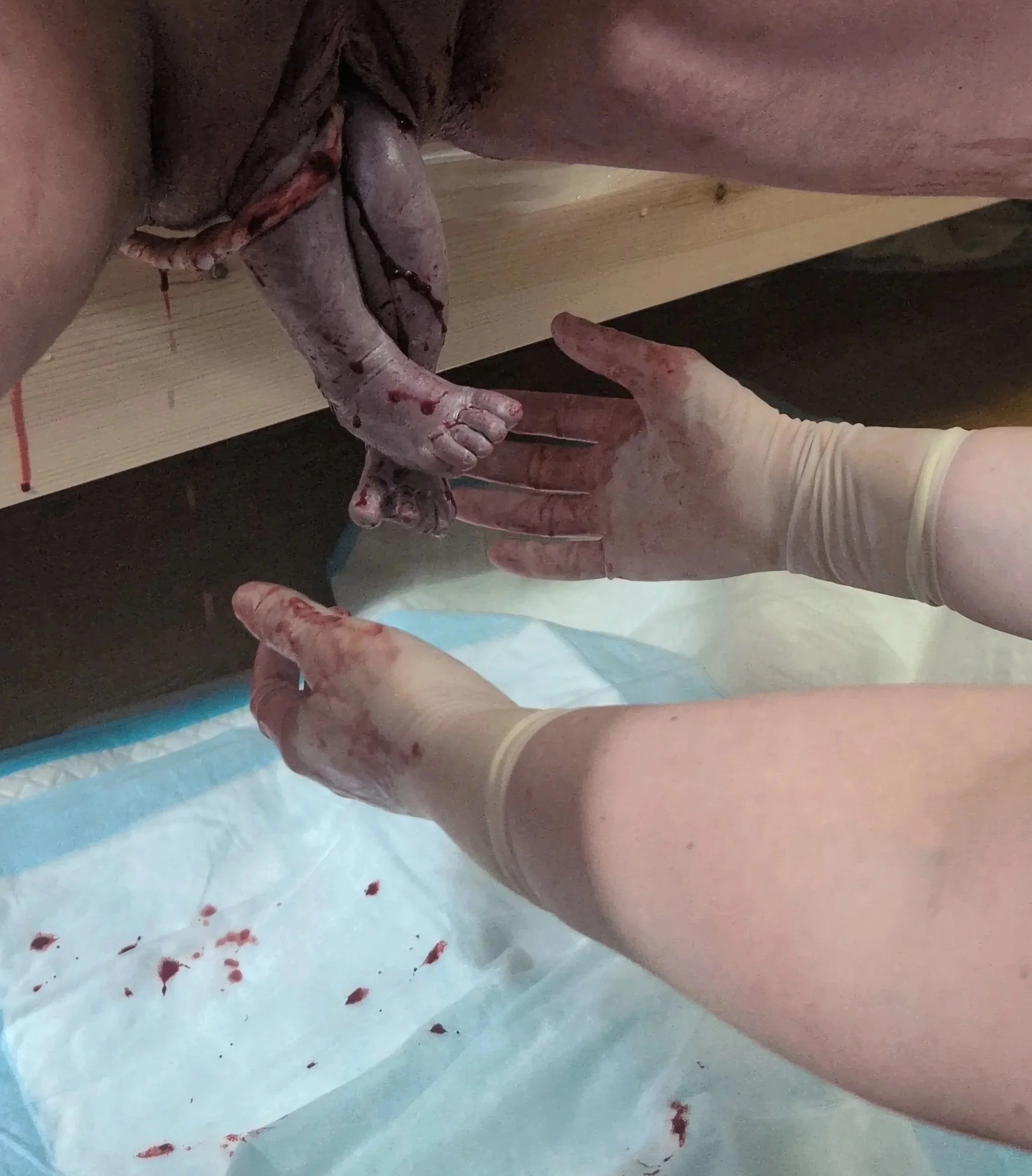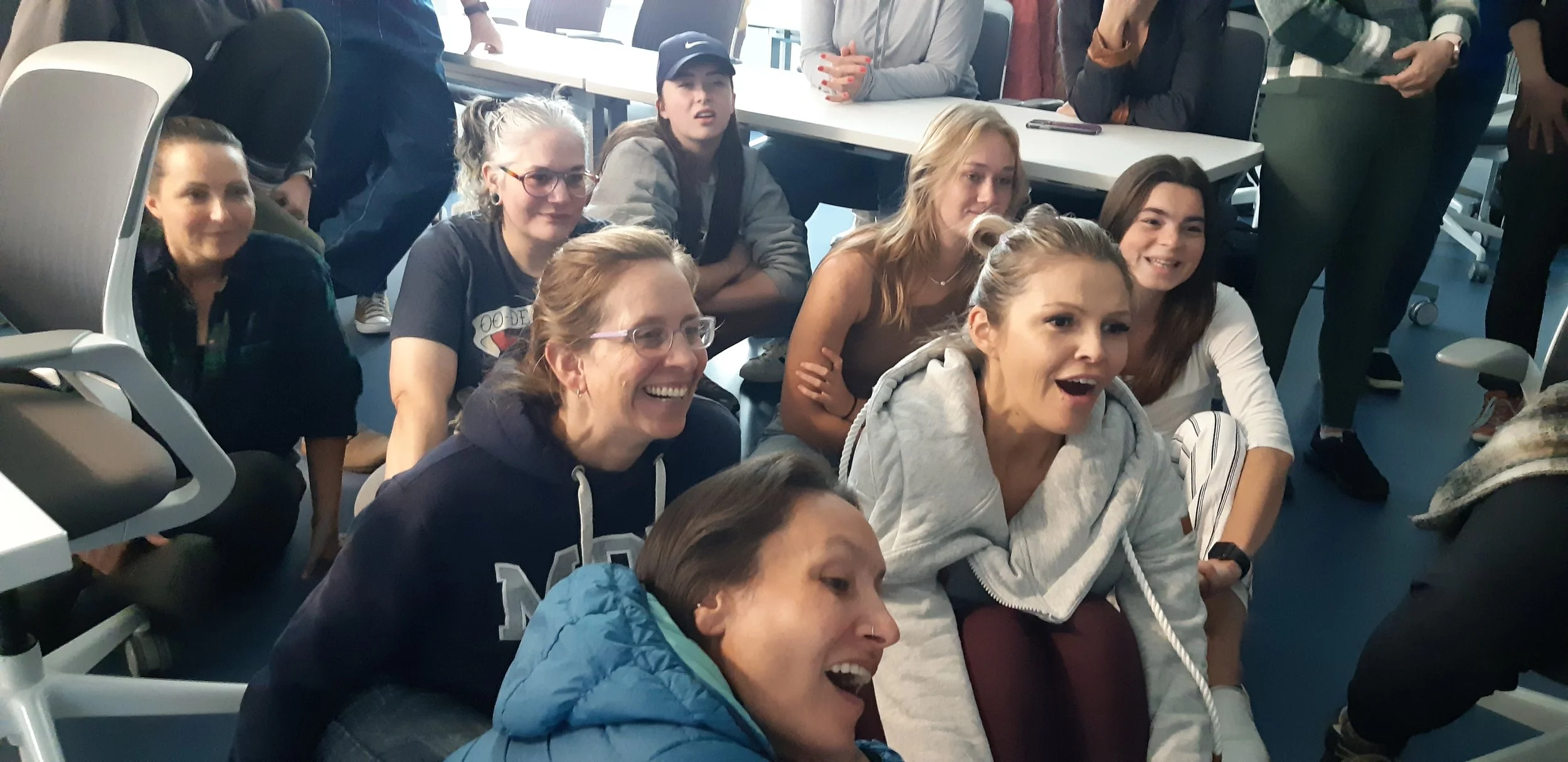
The Breech POWER Course is the outgrowth of two decades of collaboration between established Australian and Canadian breech providers and epidemiologists who have been involved in breech research in North America, Australia, and Europe.
We brought you the research on outcomes at centres in Frankfurt, Ottawa, Newcastle, and Sydney, and the two largest studies to date on Upright Vaginal Breech Birth.
Now the BABE course (Birthing a Breech Education) of Australia is joining with members of the National Breech Society of Canada (NBSC) in creating an online+in-person course.
BREECH POWER COURSE 2025
POWER stands for:
Package of:
Online breech history/research, videos demonstrating manoeuvres
Workshop/conference for in-person hands on training (BABE course)
Experience in attending actual births in centres with high volume
Review: cases/videos/protocols with peers/experienced practitioners
More About the Online Breech Course
The online course modules feature videos that demonstrate how to do the manoeuvres in both the dorsal and upright positions. Sample videos of actual births show when and how effective the manoeuvres are.
The modules also have interviews and presentations of Australian, Canadian, and European breech providers, clinical epidemiologists, and ethnographers. They review the history and politics of breech birth and grapple with the controversies over best practice in management of breech and best form of research to study outcomes. Their studies are reviewed and accessible on the site along with other breech studies.
In-Person Workshops: the BABE Course
(In Canada: "Birthing a Breech Event")
Our first workshop combined with the online modules was held in Calgary, Alberta, Canada Nov. 15-16, 2025. 7 obstetricians, 1 medical student going into obstetrics, 1 Family Medicine resident, and about 30 midwives were in attendance.
Presenters and trainers were from obstetrics, midwifery, neonatology, and epidemiology.
In these in-person trainings, you will have the opportunity to engage in reviews of videos and do hands-on training on the Sophie Models and the new models being developed by Lisa Cowdery, midwife and trainer from Red Deer, Alberta.
Peer and Practice Review Arrangements for Breech Birth Attendance
Peers and practitioners with ample experience will hold private and group peer reviews. These will be on dates that will be identified on this website after November 2025.
Once you have attended one of the in-person sessions and taken the online modules, our Breech Attendance Committee will provide you with contacts to arrange to attend breeches locally or abroad in hospitals that identify as having larger breech birth attendance than the average. This will include Frankfurt, Ottawa (only for practitioners in Ottawa), Australia (largely only for Australians), potentially Brazil and Mexico.
Prices
In Person 2 day Calgary workshop
$500 CAD.Online course
$300 CAD.Both Online Course and In-Person Calgary Workshop
$700 CAD.
Testimonials
Why Vaginal Breech Birth Has Continued to be an Option in Calgary
Dr. Bisits - Newcastle Breech Service Origins
Elisabeth Cisa-Pare, MD, Family Medicine Resident, Sudbury, Ontario, who struggled herself to access a vaginal breech delivery.
Why Andre Lalonde thinks we should continue to attend vaginal breech deliveries and teach it. (The present CEO of the International Childbirth Initiative, and the Vice Executive President of the Society of Obstetricians and Gyncecologists of Canada between 1991-2012)
Holly Umana, RM, Breech Practitioner and Instructor, Calgary
Collaboration Among
Obstetricians, Family Physicians, Midwives, Nurses,Neonatologists and Epidemiologists
Purpose of the Course
The purpose of the course is to create a safe space for all health care practitioners to be exposed to new ideas and develop together a better understanding of breech management—online, at workshops and conferences, and at actual births. Midwives and physicians have been saying they know their Colleges support their offering vaginal breech but they don’t feel personally comfortable doing so without enough training or hands-on opportunity. We intend to have this course provide you with the missing gaps along with accreditation for the efforts you are putting into learning.
We find it useful in our present milieu to create an online community of providers that can bring their difficult breech births to each other and to more experienced breech providers to offer help at actual births or to debrief them. Online peer review can become necessary if it is difficult to find somebody in your own jurisdiction with enough breech experience or there is hostility about your provision of breech care in your community and you have had a bad case. You may need a second opinion for collegial support and defence of what you did.
Vaginal Breech on the Back or Upright
While the burgeoning research demonstrates that upright breech* reduces manoeuvres, and may improve neonatal outcomes and reduce cesareans, we acknowledge that some practitioners remain more confident using the dorsal manoeuvres. In addition. if a birthing person chooses to birth with an epidural and “walking” epidurals are not available, birth on the back may become necessary. We want to reinforce that offering vaginal breech is the key & can be accomplished in many different positions. Therefore we teach manoeuvres for both dorsal and upright breech birth.
Why Practitioners Are Taking This Course
The main objective for practitioners through these courses is to update their skills at breech birth. We are therefore uploading first module 5 and 7 of the online course below, the videos explaining how to do the new manoeuvres in the upright position and videos showing actual births to demonstrate when and how the manoeuvres are used in real life. It would be useful for you to review at least module #5 and #7 before you attend the in-person course in November in Calgary. All of the parts about the history and research will not have been created by November but they will be added in the months following. The online course and videos will be available for you for 24 months.
We plan to conduct other workshops in Canada and Australia. These in-person workshops will continue to be called the BABE course but they will be intimately connected with the Breech POWER course and the Canadians have changed the acronym BABE to spell out '“Birthing a Breech Event,” because it is quite a process.
If in the future practitioners want us to travel to other countries to provide a course, we are open, but most of us have busy practices and cannot do that as frequently as we may like, especially if we are the only vaginal breech provider in town willing to be on call.
*”Upright was defined in our Frankfurt article to include on hands and knees, on the knees leaning over a couch or the back of the hospital bed, on the birth stool, squatting, or standing.
Meet Your Instructors
Dr. Andrew Bisits
Andrew Bisits recently retired as the Director of Obstetrics at the Royal Hospital for Women, Sydney, Australia, a tertiary academic hospital which oversees 4000 births per year. He moved there from Newcastle, 150km north of Sydney, where he had been the Director of Obstetrics for eight years. Dr Bisits was in full time obstetrics for 40 years (which includes the training and residency positions).
He has had a strong interest in breech birth since the term breech trial was first planned. In the research arena he has a strong leaning towards epidemiology and biostatistics. In the clinical arena he has participated in several initiatives to promote normal birth through helping establish primary midwifery care programs for pregnant women. Dr Bisits has a conjoint associate professorial position with the UNSW (University of New South Wales) and is on the Australian board of ALSO (advanced life support in obstetrics).
Dr. Meriah Fahey
Dr. Meriah Fahey is a Royal College–certified specialist in Obstetrics and Gynecology. Born and raised in Calgary, she began her medical training at the University of Calgary before completing residency at the University of Manitoba, where she was mentored by many influential leaders in the field, including Dr. Savas Menticoglou, author of the SOGC Guidelines that continue to shape the support of vaginal breech birth across Canada, and the world.
After residency, Dr. Fahey returned to Alberta, working as a locum physician before joining South Health Campus (SHC) in 2013. She is now the Site Lead for SHC and maintains a generalist practice in both obstetrics and gynecology. Her work spans several sites, including South Health Campus, Foothills Medical Centre, and collaborative clinics at Elbow River Healing Lodge, Eden Valley, and Tsuut’ina Nation. She has particular interests in breech birth, menopause, Indigenous health, and environmental health.
Dr. Fahey also leads Calgary’s program for vaginal breech birth, working alongside 12 outstanding obstetric colleagues and dedicated low-risk providers to expand safe access and patient choice. Her published research includes Outcomes of a Breech Birth Program in Canada, Quality Assurance Project (JOGC, 2021) and Women’s Selection of Mode of Birth for Their Breech Presentation (JOGC, 2021).
She looks forward to continued work and excellence in obstetrical care and is especially excited to support the upcoming local conference in Calgary this November
Betty-Anne Daviss RM,MA
Betty-Anne Daviss is an Adjunct Professor in Women’s Studies and a Canadian midwife who has practiced for 50 years in various settings in Canada, USA, Latin America, and Afghanistan. She has been the scientific co-ordinator for 3 breech conferences and attended over 200 planned vaginal breech births..
A researcher for 40 years in the social sciences and clinical epidemiology, she has published on human rights in childbirth, vaginal breech, avoiding arbitrary timelines in labour, VBAC and PPH. She co-authored with Ken Johnson, the largest North American prospective home birth study for its time (BMJ 2005, downloaded over 600, 000 times).
Of 4 volumes she co-edited on models for maternity care, she considers Birthing Models on the Human Rights Frontier: Speaking Truth to Power (Routledge 2021) to be the most critical treatise offering templates for global change. It is a colourful academic and activist treatise chronicling how human rights violations in childbirth, like other social justice issues, can be turned around in dynamic communities.
Although she attended her first breech in 1976, Betty-Anne did not gain privileges as an “MRP”(Most Responsible Person) at breech births in hospital until 2013--at l’Hôpital Montfort in Ottawa due to a forward-thinking Head of Obstetrics, Dr. Dan Moreau. She has had no newborn deaths or long-term negative sequelae as MRP at breech births.
Her research began in earnest in 2007 when she negotiated attending breeches in Frankfurt, mapped the cardinal movements of the breech, analyzed the 2004-2011 data with Dr. Ken Johnson, and wrote the article comparing upright to dorsal positions, “Does Breech Delivery in an Upright Position instead of on the back improve outcomes and decrease cesareans?“ (IJGO 2017) for the Frankfurt team. Some of her other Frankfurt/North American publications can be found on her website at www.understandingbirthbetter.com. Her breech manual about the history, research and manoeuvres for breech, Rethinking the Physiology of Breech Birth, is in its 18th edition and being printed in Australia for use in the BABE course.
Dr. Kenneth C. Johnson
Kenneth C. Johnson, PhD, is an Adjunct Professor at the School of Epidemiology and Public Health, University of Ottawa, and was a Research. Scientist/Senior Epidemiologist with the Public Health Agency of Canada and Health Canada (1982–2013). His work there focused on cancer risks associated with environment, occupation, diet and physical activity. Since 2014, his major focus has been on the renewable energy revolution and pushing for broad action on the climate crisis.
His early perinatal epidemiology work included research on the limitations of randomized controlled trials in perinatal research. From 1991 to 2004 he was the epidemiologic consultant with the Midwives Alliance of North America (MANA) Statistics and Research Committee, helping to establish MANA’s long-term collection of home birth data.
He was the co–principal investigator of the CPM2000, a prospective study of 5,418 planned home births with Certified Professional Midwives in North America, published in the British Medical Journal in 2005. He has collaborated on a number of commentaries on the epidemiologic shortcomings of specific home birth and vaginal breech studies and meta-analyses.
He was the analyst for the largest cohort study of upright vaginal breech birth to date, published in 2017, utilizing data from Frankfurt, Germany that helped establish the evidence that upright vaginal breach was not only safe, but the preferred method of breech delivery.
Dr. Abhay Lodha
Neonatologist, Clinical Researcher and Perinatal Epidemiologist and Educator. Dr. Abhay Lodha is a distinguished neonatologist, revered educator, and groundbreaking researcher in the field of pediatrics. With a robust background in neonatology, Dr. Lodha currently holds the esteemed position of Professor of Pediatrics at the University of Calgary in Canada. Dr. Lodha's commitment to advancing the medical landscape is exemplified by his multifaceted roles. He has taken on the mantle of Scientific Chair at the American Academy of Pediatrics District 8 SONPM, where he spearheads the organization's scientific endeavors. Additionally, his leadership extends to the realm of medical education, as he serves as the Chair of Continuous Medical Education at the University of Calgary. In this capacity, he plays a pivotal role in shaping the educational experiences of aspiring medical professionals. His association with esteemed societies such as the American Pediatric Society, Society of PediatricResearch, and American Academy of Pediatrics underscores his prominence within the pediatric community. Dr. Lodha's unwavering dedication to the betterment of pediatric healthcare is reflected in his myriad accomplishments.
At the heart of Dr. Lodha's contribution lies his fervent research focus on preterm birth deferred cord clamping and its far-reaching health implications. His extensive body of work, comprising 160 peer-reviewed scientific papers, 11 chapters, and invited articles, along with 140 scientific abstracts, showcases his profound impact on the field. His research not only delves into the intricacies of preterm birth but also investigates the broader health outcomes associated with it. Dr. Abhay Lodha's exemplary career serves as an inspiration to the medical community. Through his pioneering research, dedicated education leadership, and influential roles in prestigious organizations, he continues to shape the future of neonatology, leaving an indelible mark on the field and improving the lives of countless young patients.
Upcoming Events:
If you have at least 12 people willing to hold an event in your city, contact us and we will see what we can do to arrange for a training. We are not advertising this widely. So far it is occurring only in Australia and Canada, but if you want more information, just contact us.
Note the $100 discount if you apply for both the In-Person Conference and the Online Course
Introduction to the Online Breech POWER Course
Dr. Meriah Fahey, Calgary
Professor Betty-Anne Daviss, Ottawa
Dr. Ken Johnson, Ottawa
Dr. Andrew Bisits, Sydney
Note: It is necessary to register for the online course either separately or in tandem with a breech workshop or conference.
Module Curriculum
Note: Modules are in process. Module 1 and 5 are up and Module 7 should be up soon. We are adopting to changes in it, bolstered by the success of the Calgary Conference and new videos coming to us regularly now. We are waiting for confirmation for the use of some of them.The other modules will be up over the next few months. till after the Calgary conference. Email breechpowercourse@gmail.com for any further questions for help with the modules or questions about them.











